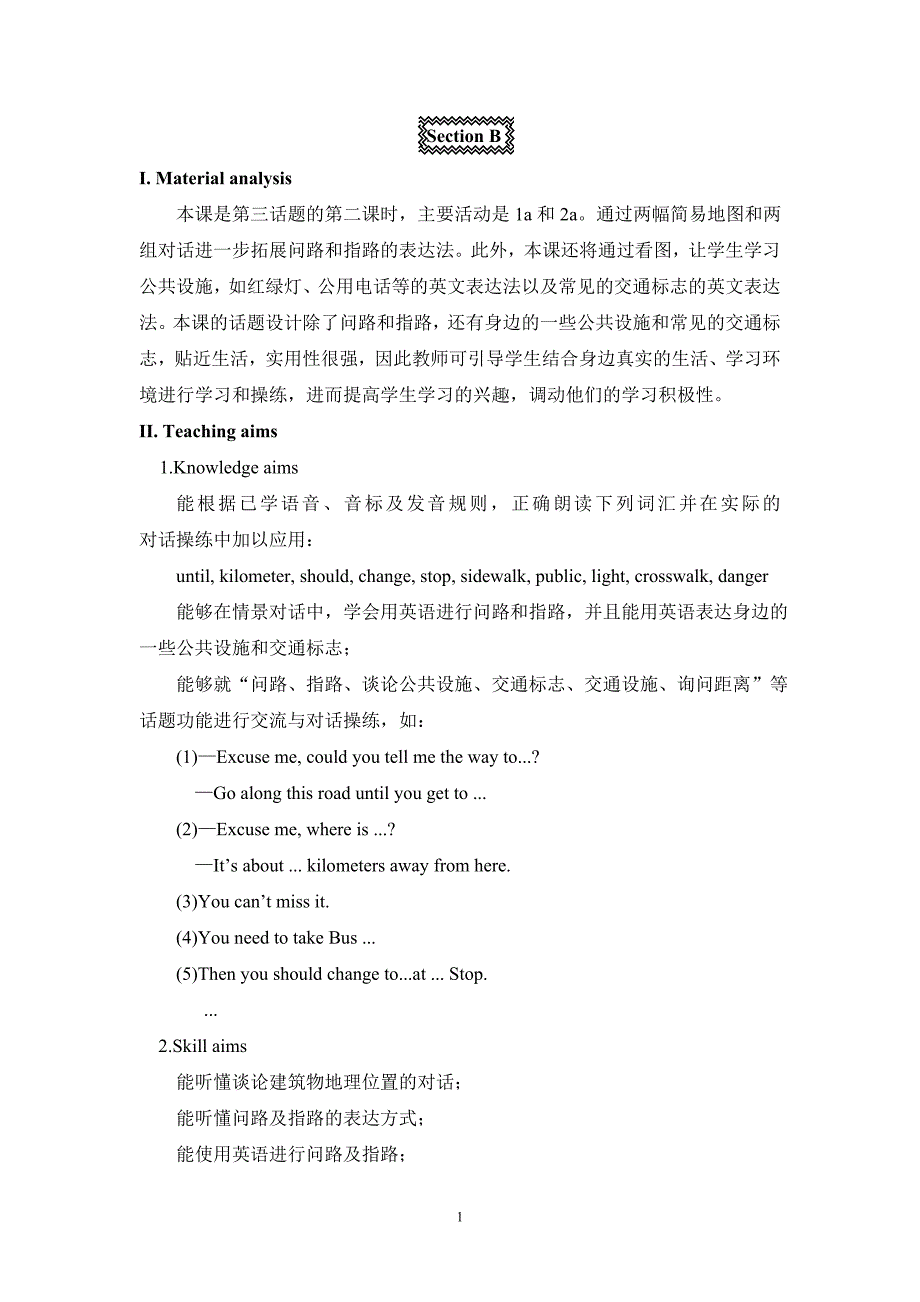 仁爱七下U6T3SB
仁爱七下U6T3SB



《仁爱七下U6T3SB》由会员分享,可在线阅读,更多相关《仁爱七下U6T3SB(9页珍藏版)》请在装配图网上搜索。
1、Section B I. Material analysis 本课是第三话题的第二课时,主要活动是1a和2a。通过两幅简易地图和两组对话进一步拓展问路和指路的表达法。此外,本课还将通过看图,让学生学习公共设施,如红绿灯、公用电话等的英文表达法以及常见的交通标志的英文表达法。本课的话题设计除了问路和指路,还有身边的一些公共设施和常见的交通标志,贴近生活,实用性很强,因此教师可引导学生结合身边真实的生活、学习环境进行学习和操练,进而提高学生学习的兴趣,调动他们的学习积极性。II. Teaching aims1.Knowledge aims 能根据已学语音、音标及发音规则,正确朗读下列词汇并在实际的
2、 对话操练中加以应用: until, kilometer, should, change, stop, sidewalk, public, light, crosswalk, danger 能够在情景对话中,学会用英语进行问路和指路,并且能用英语表达身边的一些公共设施和交通标志; 能够就“问路、指路、谈论公共设施、交通标志、交通设施、询问距离”等话题功能进行交流与对话操练,如: (1)Excuse me, could you tell me the way to.? Go along this road until you get to . (2)Excuse me, where is .?
3、Its about . kilometers away from here. (3)You cant miss it. (4)You need to take Bus . (5)Then you should change to.at . Stop. .2.Skill aims能听懂谈论建筑物地理位置的对话;能听懂问路及指路的表达方式;能使用英语进行问路及指路;能在口头表达中做到发音清晰,语音语调准确; 能正确朗读对话,注意语音语调;能读懂简单的英文地图;能读懂简单的交通标志和交通规则; 能使用所学表达法进行对话写作,描述到达某建筑物的路线。3.Emotional aims认识交通标志、学习交
4、通规则,同时增强交通安全意识,珍爱生命;能够与同伴积极合作,参与课堂活动,大胆实践;能够在课堂活动中培养乐于助人的观念。III. The key points and difficult points 能够在情景对话中,就“问路、指路”等话题功能用英语来表达方向以及建筑物的地理位置,同时能够在对话中谈论公共设施和常见的交通标志。IV. Learning strategies1.能够养成运用图片、关键词等帮助听说的学习策略;2.能够清楚、大声地进行朗读,认真听录音和老师的发音,大胆开口,反复模仿;3.能在学习过程中养成结合实际学习英语的好习惯。V. Teaching aids 录音机、教学挂图、
5、闪卡和黑板VI. Teaching proceduresStepInteraction patternStudent activityTeacher activityIntroduction (5 minutes)1. The whole class work.2. Pair work.3. Individual work.1. Focus your attention on the teacher. 2.Do duty report. Draw your own map to describe how to get to the school from your home. Make up
6、a new conversation in pairs. Then practice the conversation. Some pairs show your maps and act out the conversations to the whole class.e.g.A: Maria, how can you get to your school?B: Well, I live on Guangqian Road. Go up Guangqian Road and turn left at the second crossing. Its on West Street. Go do
7、wn West Street to the end. The school will be on my right. And you?A: .3. Look at the picture of 1a in Section A. Listen to the teachers questions about asking ways. Try to answer the teachers questions as quickly as you can. T: Suppose I am in A place. Now how can I get to the library?S1: Go along
8、Xinhua Street and turn right at the first crossing. Its about twenty meters along on the left.T: Good. Now, which is the way to the hospital?S2: .T: Could you tell me the way to./Where is .(Lead to the new expressions about asking ways in conversation. )S3: Go along . until you get to . Turn left an
9、d walk on.1.Get students ready for learning.2. Help the students revise the words and expressions in the last topic. 3. Help the students revise the expressions about asking ways and giving directions.Presentation (10 minutes)1. Individual work and pair work.2. Individual work and pair work.1. Look
10、at the pictures in 1a. Answer the following questions:(1)How can you get to Dinghao Building?(2)At which bus stop can you change to the No.108 bus?Listen to the tape and check your answers.Read the phrases in 1b. Guess the answers in the blanks. Then listen again and write down the key words or phra
11、ses in 1b. Listen to the tape the third time and check the answers with your partner.2.Do 1c. Read 1a again. Underline the sentences in 1a about asking ways and giving directions. Check with your partner.1. Make the students learn to use the pictures and diagrams to help them listen. Play the tape r
12、ecorder and check the answers.2.Make the students find the functional sentences by themselves.Consolidation (10 minutes)The whole class work and pair work.Read 1a after the tape. Practice the conversation in pairs based on 1b. Some pairs act out the conversation to the whole class.Play the tape reco
13、rder. To be a good listener. Practice(10 minutes)1. Individual work, pair work and the whole class work.2. The whole class work.3. Group work and individual work.1. Do 2a. Look at the pictures in 2a. Complete the conversations individually before listening. Then listen to the tape and check your ans
14、wers. After that, check your answers with your partner. Listen again and read after the tape. The whole class check the answers. Practice the conversations in pairs.2. Do 2b. Look at the pictures in 2b about the public facilities. Learn some new words, public, light, sidewalk, crosswalk. Do brainsto
15、rming. Try to say the words about public facilities as many as you can.Look at the pictures on the screen. Try to say the words as quickly as you can.3. Sit in groups. Discuss with your group members about the traffic signs around you in your real life. Draw them down. Then some groups show your pic
16、tures to the whole class and teach the words of traffic signs to the whole class .Then do 3. Look at each sign in 3 and match it with its meaning individually. Check the answers with your group members.Discuss in groups about the differences between the eastern traffic signs and western traffic sign
17、s.1.Play the tape recorder. Check the answers. To be a good listener. 2. Show pictures. Present and practice new words.3. Help the students learn some words about traffic signs with the help of the pictures by themselves.Production (10 minutes)Pair work. Sit in pairs. Look at the map given by the te
18、acher on the screen. Make up new conversations about asking ways and giving directions in pairs. Practice them. Then some pairs act out your conversations to the whole class.A: Excuse me, where is the bank?B:Go along Zhongshan Road until you get to the end. Turn right. Its on your left. You cant mis
19、s it.A: Thanks a lot.B: Youre welcome.1. Make the students learn to use what they have learned in real situation.2. Assign the homework:Review the words and practice the conversations in Section A with your partner;Go on making conversations about how to asking ways and giving directions in pairs. T
20、hen report it to the class next day;Preview Section B;Collect more traffic signs in your life.Teaching reflection: 在本课中,学生在听力活动与两两对话中,学习并操练了关于“问路”和“指路”的表达方式。“问路”和“指路”是我们生活中常见的话题,但是有的学生方向感不强,尤其在平面地图中经常会迷失方向,因此,教师可引导学生结合身边真实的生活环境来操练“问路”和“指路”的对话,这样一来,学生就能比较直观、有效地学习并掌握这两个话题功能的用法。同样地,本课学习了交通标志以及身边一些公共设施的
21、英语表达,教师可引导学生在课外多在身边发现类似的标志,并尝试用英语表达。VII. Blackboard designTopic 3 How can I get to the library?Section B1.Could you tell me the way to .? until2.Go along. until you get to . kilometer3.Turn left and walk on. should4.You cant miss it. change5.Where is .? stop6.You should change to the No.108 bus sidewalk public light crosswalk danger9
- 温馨提示:
1: 本站所有资源如无特殊说明,都需要本地电脑安装OFFICE2007和PDF阅读器。图纸软件为CAD,CAXA,PROE,UG,SolidWorks等.压缩文件请下载最新的WinRAR软件解压。
2: 本站的文档不包含任何第三方提供的附件图纸等,如果需要附件,请联系上传者。文件的所有权益归上传用户所有。
3.本站RAR压缩包中若带图纸,网页内容里面会有图纸预览,若没有图纸预览就没有图纸。
4. 未经权益所有人同意不得将文件中的内容挪作商业或盈利用途。
5. 装配图网仅提供信息存储空间,仅对用户上传内容的表现方式做保护处理,对用户上传分享的文档内容本身不做任何修改或编辑,并不能对任何下载内容负责。
6. 下载文件中如有侵权或不适当内容,请与我们联系,我们立即纠正。
7. 本站不保证下载资源的准确性、安全性和完整性, 同时也不承担用户因使用这些下载资源对自己和他人造成任何形式的伤害或损失。
